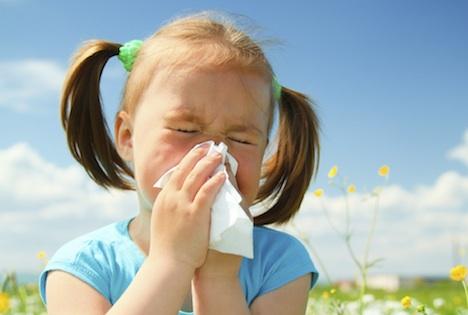Australia has one of the highest reported incidences of allergies in the world. In fact, one in 10 babies born in Australia today will develop a food allergy.
Here are some common clues that could lead you to suspect your child may have an allergy:
- Repeated or chronic cold-like symptoms that last more than a week or two, or develop at about the same time every year. These could include an itchy, runny nose, nasal stuffiness, sneezing, throat clearing, and itchy, watery eyes.
- Recurrent coughing, wheezing, chest tightness, difficulty breathing, and other respiratory symptoms may be a sign of asthma. Coughing may be an isolated symptom; symptoms that increase at night or with exercise are suspicious for asthma.
- Recurrent red, itchy, dry, sometime scaly rashes in the creases of the elbows and/or knees, or on the back of the neck, buttocks, wrists, or ankles.
- Symptoms that occur repeatedly after eating a particular food that may include hives, swelling of face or extremities, gagging, coughing or wheezing, vomiting or significant abdominal pain.
- Itching or tingling sensations in the mouth, throat and/or ears during certain times of year or after eating certain foods, particularly fresh (raw) fruits. Typically, however, cooked forms of the food are tolerated.
Common allergies around the home
- Dust mites (microscopic organisms found in bedding, upholstered furniture and carpet as well as other places)
- Furred animal allergens (dogs, cats, guinea pigs, gerbils, rabbits)
- Pest allergens (cockroaches, mice, rats)
- Pollen (trees, grasses, weeds)
- Molds and fungi (including molds too small to be seen with the naked eye)
- Foods (cow's milk, eggs, peanuts, tree nuts, soy, wheat, fish and shellfish)
How to manage allergic nasal symptoms
Nasal allergy symptoms can be caused by a variety of environmental allergens including indoor allergens such as dust mites, pets, and pests as well as outdoor allergens such as pollens. Molds, which can be found indoors and outdoors, can also trigger nasal allergy symptoms.
Allergy testing should be performed to determine whether your child is allergic to any environmental allergens.
An important step in managing allergy symptoms is avoidance of the allergens that trigger the symptoms.
If your child is allergic to pets, the addition of pets to your family would not be recommended. If your child has allergy symptoms and is allergic to a pet that lives in your home, the only way to have a significant impact on your child’s exposure to pet allergens is to find the pet a new home.
If your child is allergic to pests present in the home, professional extermination, sealing holes and cracks that serve as entry points for pests, storing foods in plastic containers with lids and meticulous clean up of food remains can help to eliminate pests and reduce allergen levels.
Dust mites congregate where moisture is retained, and food for them (human skin scales) is plentiful. They are especially numerous in bedding, upholstered furniture, and rugs. Padded furnishings such as mattresses, box springs, and pillows should be encased in allergen-proof, zip-up covers, which are available through catalogs and specialized retailers. Wash linens weekly and other bedding, such as blankets, every 1 to 2 weeks in hot water. The minimum temperature to kill mites is 130 degrees Fahrenheit. If you set your water heater higher than 120 degrees, the recommended temperature to avoid accidental scald burns, take care if young children are present in the home.
If your child is allergic to outdoor allergens, it can be helpful to use air conditioners when possible. Showering or bathing at the end of the day to remove allergens from body surfaces and hair can also be helpful. For patients with grass pollen allergy, remaining indoors when grass is mowed and avoiding playing in fields of tall grass may be helpful (during grass pollen season).
Children with allergies to molds should avoid playing in piles of dead leaves in the fall. Pets tracking in and out of the house can also bring pollen and mold indoors.
Medications to control symptoms
Your child's allergy treatment should start with your pediatrician, who may refer you to a pediatric allergy specialist for additional evaluations and treatments.
- Antihistamines – Ones taken by mouth can help with itchy watery eyes, runny nose and sneezing, as well as itchy skin and hives. Some types may cause drowsiness.
- Nasal Corticosteroids - Highly effective for allergy symptom control and are widely used to stop chronic symptoms. Safe to use in children over long periods of time. Must be used daily for maximal effectiveness.
- Allergy Immunotherapy - Immunotherapy, or allergy shots, may be recommended to reduce your child's allergy symptoms. Allergy shots are prescribed only for patients with confirmed allergy. If allergen avoidance and medications are not successful, allergy shots for treatment of respiratory allergies to pollens, dust mites, cat and dog dander, and molds can help decrease the need for daily medication.
Ask your doctor about additional therapies.
Source with permission: Allergies and Asthma: What Every Parent Needs to Know, by the American Academy of Pediatrics



















__small.png)










